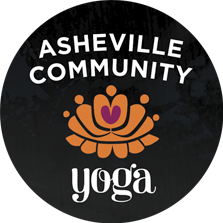Informed by both modern science and ancient texts, the Asheville Community Yoga 250-hour teacher training comprises asana, pranayama, meditation and kirtan. Through the dual lenses of theory and practice, we will delve into methods for safely and effectively teaching asanas to a room of different bodies, abilities and levels in styles ranging from gentle to vinyasa. Providing the tools to explore yourself and educate others, our program fosters an insightful examination and clear articulation of the art and science of yoga through traditional and evidence-based perspectives.
Topics
- Asana
- Alignments
- Modifications
- Adjustments
- Surya namaskaras
- Sun salutations A & B
- Vinyasa flow
- Languaging
- Physical cues
- Energetic cues
- Class structure
- Sequencing
- Theming
- Bhav (the vibe)
- Cultivating a home practice
- Daily asana
- Daily pranayama
- Daily meditation
- Pranayama (breathing technique)
- Meditation
- Restorative yoga
- Yoga nidra (relaxation technique)
- Chakra theory and practice
- Ayurveda
- Self care
- Yogic nutrition
- Therapeutic yoga
- Yoga history
- Vedic path
- Tantric path
- The Yoga Sutras of Patanjali
- The eight-limbed path
- Yamas and niyamas
- Yoga ethics
- Who is a yoga teacher?
- Why teach yoga?
- Honoring teacher/student relationships/boundaries
- Class labels and studio policies
- The Bhagavad Gita
- The Spirit of Devotion (Bhakti Yoga)
- The Spirit of Service (Karma Yoga)
- Service project
- The Business of Yoga
- Branding and marketing
- Professionalism
- Yoga Alliance
- Practicum
- Student teaching
Curriculum
Techniques, Training and Practice
Total Hours: 120
Asana: Through discussion, active demonstration, and use of the trainee handbook, we will identify alignment and cuing for stable and safe movement and posture within the following categories.
- Tadasana (mountain pose: the foundation)
- Sun salutations
- Downward facing dog and transitions to and from (“Vinyasa Flow”)
- Standing poses
- Back bends
- Forward bends
- Twists
- Standing balances
- Arm balances
- Inversions
We will identify how key muscle groups affect flexibility and strength in these poses. Conversation will focus on how to cue based on the energetic effects of these postures and the risk factors inherent to practicing them incorrectly.
Pranayama: The training will include multiple pranayama modules where students will gain a first hand experience of the physical, mental, emotional and sometimes spiritual effects that can occur when pranic flow is controlled and manipulated.
Meditation: Students will be encouraged to cultivate a daily meditation practice and will be guided through various techniques used for meditation including mantras and visualizations.
Restorative yoga/yoga nidra: A discussion and practice on the deeply rooted physical, mental and emotional impacts of restorative yoga and yogic sleep.
Teaching Methodology
Total Hours: 50
Through discussion, active demonstration, and use of the trainee handbook, we will explore ways to keep a class safe, effective and engaging. The following modules will be explored:
- Modifications
- Adjustments
- Sequencing
- Class themes
- Holding space
- Creating atmosphere
- Finding your voice
- Trusting your inner teacher
Anatomy and Physiology
Total Hours: 20
We will cover a general overview of all major systems of the body including the:
- Skeletal system
- Muscular system
- Digestive system
- Endocrine system
- Fascial system
- Cardiovascular system
- Nervous system
- Lymphatic system
In addition, within each of the above mentioned asana modules, we will identify key muscles groups and joints affected by the postures. We will also identify where and when the following movements occur within the poses:
- Flexion and extension
- Abduction and adduction
- Medial and lateral rotation
- Pronation and supination
We will also cover subtle anatomy which includes:
- Pranayama
- Bandhas
- Nadis
- Chakras
Yoga Philosophy, Lifestyle and Ethics
Total Hours: 50
Through class discussion and journaling practices, we will dive into the heart of yoga, exploring what it means to live our yoga on and off the mat. These modules will explore:
- The Yoga Sutras
- The 8 Limbed Path
- The Yamas and Niyamas
- The Upanishads
- The Bhagavad Gita
- Bhakti Yoga (Devotion)
- Karma Yoga (Service)
Practicum
Total Hours: 10
Students will demonstrate their growing ability to guide others through a safe and effective yoga class. They will demonstrate their knowledge of alignment, sequencing, verbal cuing, and modifications, as well as their ability to create a peaceful atmosphere and hold space for others to explore the body, mind and spirit connection.
Required Reading
- Any translation of The Yoga Sutras of Patanjali
- The Concise Book of Yoga Anatomy by Jo Ann Staugaard-Jones
- Teaching Yoga by Donna Farhi
- The Yoga of Breath: A Step-By-Step Guide to Pranayama by Richard Rosen
- The Bhagavad Gita translated by Stephen Mitchell
Recommended Reading
- Back Care Basics by Mary Pullig Schatz
- 30 Essential Poses by Judith Lasater
- Relax and Renew by Judith Hanson Lasater
- Yoga: Mind, Body, Spirit by Donna Farhi
- The Breathing Book by Donna Farhi
- Living Your Yoga by Judith Lasater
- Yogabody by Judith Lasater
Requirements for Graduation
- Attendance each day
- Fulfilling reading and writing requirements
- Attending yoga classes
- Student teaching at least five classes
- Observing at least five classes
- Research paper or equivalent research project
- Teaching a class to the group at the end of the course
